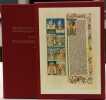11 books for « pacht otto »Edit
L'enluminure médiévale
Editions Macula, Paris, 1997. In-4, reliure pleine toile éditeur sous jaquette illustrée en couleur, 222 pp. Préface de François Avril - Introduction - I. L'insertion de l'ornementation picturale dans structure organique du livre - II. L'initiale - Planches - III. Illustrations de la Bible - IV. Illustrations didactiques - V. Illustrations de l'Apocalypse - VI. Illustrations ...
Avec 210 illustrations en noir in texte et 32 planches couleur en hors texte. --- Plus d'informations sur le site archivesdunord.com
Phone number : 01 42 73 13 41
Illuminated manuscripts in the Bodleian Library Oxford.
Oxofrd, At the Clarendon Press, 1969. In-8, rel. éd. pleine-toile enduite brune sous jaquette, 108 pp., front. en coul., 66 planches de reprod. en n/b., texte sur 2 colonnes en anglais, index.
Tome 1 seul. Très bon ex. - Frais de port : -France 6,9 € -U.E. 11 € -Monde (z B : 18 €) (z C : 31 €)
L'enluminure médiévale. Une introduction.
Paris, Macula, 1997. In-4, rel. pleine toile roue de l'éd., titre doré, sous jaquette ill. en coul., 222 pp., 210 fig. in-t., XXXII pl. en coul. hors-t., glossaire, index.
Très bon ex. - Frais de port : -France 6,9 € -U.E. 11 € -Monde (z B : 18 €) (z C : 31 €)
FRANZÖSISCHE SCHULE I und II.
Wien 1974. 2 vol. in-4 (texte et planches), reliure d'édition pleine toile bordeaux, titre doré au dos et sur le 1er plat, réunis sous étui de même toile, illustré d'une reproduction en couleurs, 198pp, 49 fig. en noir; le second voL contient 375 illustrations en N/B et 8 planches en couleurs
Comme neuf - Frais de port : -France 8,45 € -U.E. 13 € -Monde (z B : 23 €) (z C : 43 €)
Book Illumination in the Middle Ages (Studies in Medieval and Early Renaissance Art History)
Oxford 1987 Oxford University Press Hardcover 1st Edition
Book Illumination in the Middle Ages (Studies in Medieval and Early Renaissance Art History) 285 x 205 mm, hardcover with dustwrapper , 224 pp , illustrated, good condition
The Master of Mary of Burgundy
London, 1948, in-8, 72pp & 48 vignettes, broché, Superbe exemplaire! 72pp & 48 vignettes
Flämische Schule II. 2 vols.
Wien, Verlag der Österreichischen Akademie der Wissenschaften, 1990. Folio. In the original 2 uniform red full cloth bindings with gilt lettering to spine and front board housed in matching casette. Ex-libris pasted on to verso of front board. A very fine and clean set. [Text vol.:] 158, (58) [Plate volume:] 13, (168) pp.
Veröffentlichungen der Kommission dü Schrift- und Buchwesen des Mittelalters, Reihe I, Band 7
Flämische Schule I. 2 Bde. (Textbd. + Tafelbd.).
Wien, Akademie der Wissenschaften, 1983. 4to. 2 orig. full cloth in orig. slipcase. 214 pp. and 109 illustrations on plates + Platevolume with 9 colourplates and 221 illustrations on plates. Clean and fine.
The Master of Mary of Burgundy.
London, Faber and Faber, (1948). Royal8vo. Orig. full cloth. Frontispiece in colour. 72 pp., 3 colouplates and 48 illustr. on plates.
The Master of Mary of Burgundy.
London, Faber & Faber, 1948, in-8°, coloured frontispiece + 72 pp + 3 col. pl. + 48 b/w ills., publisher's cloth. (cloth and spine a bit soiled, some notes in ink on title page).
Early Netherlandish Painting from Rogier van der Weyden to Gerard David
, Brepols, 2010 Paperback, 264 p., 221 ills., 33 in colour, 210 x 280 mm, Languages: English . ISBN 9781905375707.
Otto Pacht examines the great Netherlandish painters of the 15th and early 16th century by putting emphasis on formal analysis and on direct contact with the works of art themselves, and by discussing every facet of the works including style, mood, iconography, symbolism and construction of space. Otto Pacht's studies of the Early Netherlandish painters are the fruit of a lifetime's research. Following his book on the brothers Van Eyck and their circle, this volume deals with the next generation of artists, the great figures of the 15th and early 16th century: Rogier van der Weyden, Petrus Christus, Aelbert van Ouwater, Dieric Bouts, Justus van Gent, Hugo van der Goes, Geertgen tot Sint Jans, Hans Memling and Gerard David. In the tradition of the Vienna School, Pacht's approach puts emphasis on formal analysis and on direct contact with the works of art themselves. Taking certain key works by each artist as examples, he discusses every facet of the work including style, mood, iconography, symbolism and construction of space. The chapters are linked by the theme of imitation and continuation: the author compares the same subject as treated by various artists and shows how artists adopted developed ideas and motifs first employed by their predecessors. Although his touchstone was the evidence of his eyes, Pacht was always responsive to the theories of other scholars, and this volume is a gateway to an influential period in the history of art. The proximity of the illustrations to the text enhances his account of the great figures of the period, and there is a folding plate, in colour, of Rogier van de Weyden's Last Judgement alterpiece for the chapel of the hospital, the Hotel-Dieu, in Beaume.
 Write to the booksellers
Write to the booksellers




